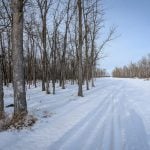Modern technology has provided some easy methods for keeping accurate track of cattle. Flokk is one new system for beef herd management and traceability reporting, and is currently undergoing initial testing. It’s designed for the cow-calf producer — large or small.
Bill Leask, a rancher near Dog Pound and Mark Olson of Carstairs, two communities just northwest of Calgary, are part of a new company involved with the technology. Flokk is the Norwegian word for herd.
“This all started a few years back when I went to the Agri-Trade Equipment Expo in Red Deer and was looking for a tag reader for our operation,” says Leask. “We were just a small operation with 100 cows and couldn’t afford a big expense. I didn’t like the options available because you needed a laptop or your phone to go with it.”
Read Also

Harvest wraps up and fall work begins
At the Eppich famly ranch in western Saskatchewan, the fall harvest was successful with few breakdowns, cows and calves have been sorted and a new tractor has arrived
The next week, Leask talked about this with Olson. “He is a techie and he thought he could build something like that would work. So this is where it started. We have a device created and it is in field trials at this moment. We are hoping to be marketing it by this fall.”
Leask says its record-keeping and herd management technology are aimed toward the smaller producer. “There’s lots of stuff out there for the bigger operations, but we were looking for something that would be usable and affordable for the small producer — something that could help with digital records.”
Most ranchers rely on handwritten records and notebooks that must be entered into a computer file. “That’s what we are trying to replace — the traditional calving book,” says Leask.
This is a digital herd management tool with all the herd records inside the device. “If you are out in the field and find a sick calf with no cow around. With the Flokk hand-held RFID tag reader, you can read that calf’s CCIA (Canadian Cattle Identification Agency) tag and it will tell you who its mother is — her hang tag number, for example.”
The Flokk tag reader does more than read tags. It has many different features which can be turned on or off to suit herd management needs. Right now, the Flokk hand-held can store information including individual ID numbers, vaccinations and medications records, preg-check and weight information, processing and other details on individual animals.
“You can input which day a certain bunch of cows was vaccinated, or when this particular calf had a shot of a certain antibiotic,” says Leask. “It will also red flag an animal if you try to send it to market before the withdrawal date of that drug. It can keep records for various treatments and when.”
If a calf gets sick at weaning you can look back and see that it was also sick and treated when it was three weeks old. During preg-testing you can also input that information.
“You can turn it on when you are preg-testing cows, and if you come to an open cow you just hit the cull button on her record when you read her tag,” Leask says. “Then if the cows get mixed with other animals again later you could run them through an alley and read their tags and it would tell you which ones are the open cows to cull.”
It is mandatory in Canada to have a CCIA tag on every animal before it leaves the farm. These can be put in at birth, though many producers don’t put them in until the animal leaves the farm, such as when weaned calves are sold. Leask has always applied the tags at birth. “It is up to the individual, but if they are put tags in earlier, they can be useful for your own purposes such as these digital records,” he says. Heifer calves kept as replacements will have these tags for the rest of their lives.
While information is collected in the corral or the field, once back to the house or office where WiFi is available, information on the hand-held can be uploaded to a spreadsheet on a computer.
The current field trials for the Flokk system are going well, says Leask. “We partnered with Olds College to do the initial testing. We are now actively engaging producers to test our product to make sure it meets their needs and operates reliably before it is offered for public sale. We have funding from RDAR (Results Driven Agricultural Research) and this is what’s paying our field trial person for the winter. This is where we’re at currently, and by spring we will be through our first field trials.”
For more information on the Flokk herd management technology, visit flokk.ca.















